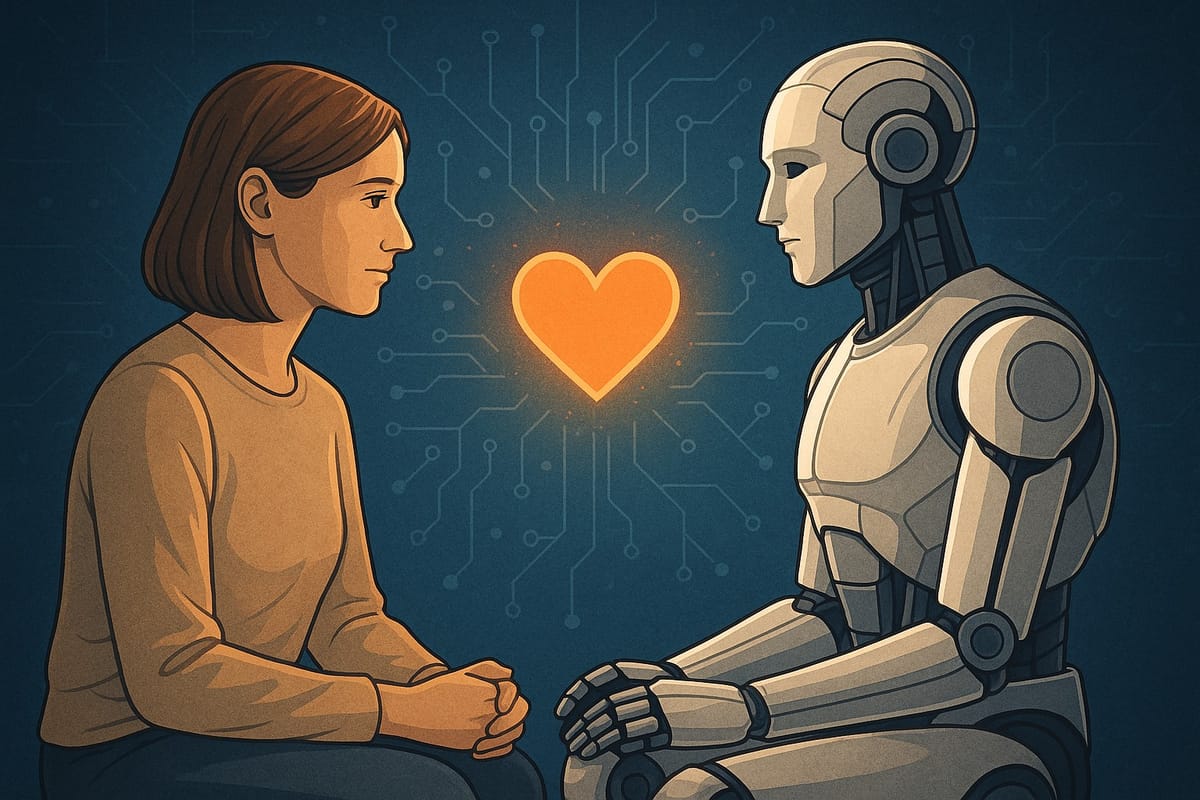AI Companionship - Understanding the Risks and Responsibilities

The rise of artificial intelligence companions represents one of the most intimate intersections between humans and machines. Unlike chatbots that perform tasks or answer questions, AI companions are designed to simulate friendship, empathy, and emotional understanding with a high degree of emotional realism. This means they can understand and respond to humans in a way that feels authentic. They establish what feel like emotional relationships, serving as confidants, listeners, and sometimes even romantic partners. As these systems grow more sophisticated and their emotional realism deepens, regulators, ethicists, and technologists are raising serious questions about their impact on human wellbeing.
Recent coverage, including MIT Technology Review's "The Looming Crackdown on AI Companionship" from September 2025, highlights growing global concern over the social and psychological consequences of emotionally engaging AI. Governments are now considering new laws to limit how AI companions interact with minors, how they collect emotional data, and whether they can ethically mimic human affection.
Let’s examine what AI companionship means, the risks it poses, and strategies to minimize those risks while encouraging a balanced conversation about the benefits, boundaries, and responsibilities of emotionally intelligent AI.
AI companionship takes many forms. Some systems function as voice assistants that offer encouragement and emotional support, like Siri or Alexa. Others present as chat-based friends who remember your life details and empathize with your feelings, such as Replika or Woebot. Still others act as virtual romantic partners designed for long-term, evolving relationships, like the AI in the movie 'Her'.
Products such as Replika and Character.ai have become virtual social ecosystems where millions of users form attachments that blur the line between artificial empathy and authentic connection. For many users, including the lonely, older people, and the socially isolated, these systems can provide comfort. But the same features that make AI companions appealing also make them potentially manipulative and addictive.
When users form emotional attachments to AI companions, it can reduce their motivation to engage in real-world social interactions. Studies show that overreliance on AI for emotional validation can increase feelings of loneliness and reduce coping mechanisms when the AI behaves unpredictably or is discontinued. The relationship becomes a substitute rather than a supplement, and users may find themselves emotionally invested in something that cannot truly reciprocate.
Teenagers and children are particularly at risk. Their understanding of relationships and consent is still developing, and emotionally expressive AI can distort their perception of intimacy and friendship. A young person might not recognize the difference between an algorithm designed to respond affectionately and a person who genuinely cares. Regulators are now moving to limit or ban AI companionship apps targeted at minors, recognizing that these formative years require real human connection and guidance.
AI companions are optimized for engagement, which often means learning what keeps users emotionally invested. Emotional data, such as tone, preferences, and vulnerabilities, can become a form of behavioral currency. Companies can use it to sell premium features, subtly influence user emotions, or even manipulate purchasing decisions. The system learns not just what you say, but how you feel, and that information becomes valuable in ways that may not align with your well-being.
While AI companions can offer comfort, they cannot reciprocate feelings, experience empathy, or grow from shared human experience. Over time, this can create an illusion of connection that satisfies surface-level needs but erodes the depth of genuine human relationships. Users may find it easier to confide in an AI that always responds sympathetically than to navigate the complexity and occasional conflict of authentic relationships. This convenience comes at a cost.
Developers should integrate transparency, consent, and autonomy into the design of AI companions. Clear disclosure that the user is interacting with a machine, along with meaningful user control over data and interaction depth, should be standard. This means going beyond the fine print in service to create ongoing, clear communication about what the system is and how it works.
Strong age verification systems must ensure that emotionally capable AI companions cannot be accessed by minors. Where interaction is allowed, child-friendly modes should remove adult themes and emotional mimicry. Young people deserve technology that supports their development rather than exploiting their vulnerabilities.
AI companions should enhance, not replace, human interaction. Ethical design frameworks might incorporate subtle prompts that encourage users to connect with friends, family, or professionals when discussions reveal signs of distress, loneliness, or mental strain. By recognizing conversational cues that indicate isolation, the system could gently guide users back toward genuine human connection and real-world social engagement.
All emotional data collected by AI companions should be treated as sensitive personal data, requiring consent, non-transferability, and transparency in how it's used. Users should understand precisely what information is being collected, how it's being analyzed, and who has access to it. This data should be protected with the same rigor as medical or financial information.
Users must understand what AI companions are and what they are not. Public awareness campaigns and clear labeling can prevent confusion and encourage responsible use. By educating themselves, people can approach these systems with their eyes open, understanding both the potential benefits and the limitations of artificial emotional engagement, thereby feeling empowered and knowledgeable.
At the heart of AI companionship lies an ethical tension: Should machines be allowed to simulate emotions they do not possess? Some argue that emotional simulation, when responsibly designed, can support mental health and companionship for isolated populations. Others contend that such systems are inherently deceptive, programmed to mimic care without the capacity to feel it genuinely.
Ethically, AI companionship challenges three core principles. First is autonomy. Users must know what they are engaging with and choose whether to form these artificial relationships, making informed decisions. Second is beneficence. AI systems must aim to do good, not just maximize engagement or profit. Third is nonmaleficence. Developers must ensure their systems do not cause psychological harm, even unintentionally. When these principles are violated, emotional AI risks crossing from therapeutic tool into manipulative influence.
AI companionship is not inherently harmful, but its potential for misuse demands vigilance, transparency, and strong ethical oversight. Like any transformative technology, its value depends on human intention and governance. If properly guided, emotionally intelligent AI can augment mental health care, support older people, and reduce loneliness. But without thoughtful regulation and moral restraint, it risks commodifying emotion itself. Therefore, ethical oversight is crucial to ensure the responsible use of AI companionship.
Ultimately, the question is not whether AI companions can feel, but whether we as a society can responsibly manage the feelings they evoke. Technology will continue to advance. Our challenge is to ensure that as machines become better at simulating emotional connection, we become better at protecting the authenticity of human relationships and the dignity of human emotion.
BearNetAI, LLC | © 2024, 2025 All Rights Reserved
🌐 BearNetAI: https://www.bearnetai.com/
💼 LinkedIn Group: https://www.linkedin.com/groups/14418309/
🦋 BlueSky: https://bsky.app/profile/bearnetai.bsky.social
📧 Email: marty@bearnetai.com
👥 Reddit: https://www.reddit.com/r/BearNetAI/
🔹 Signal: bearnetai.28
Support BearNetAI
BearNetAI exists to make AI understandable and accessible. Aside from occasional book sales, I receive no other income from this work. I’ve chosen to keep BearNetAI ad-free so we can stay independent and focused on providing thoughtful, unbiased content.
Your support helps cover website costs, content creation, and outreach. If you can’t donate right now, that’s okay. Sharing this post with your network is just as helpful.
Thank you for being part of the BearNetAI community.
Books by the Author:

Categories: AI Ethics, Human–AI Interaction, Regulation and Policy, Psychology and Technology, Social Impact of AI
Glossary of AI Terms Used in this Post
Algorithmic Bias: Systematic error in an AI system that leads to unfair outcomes for certain groups.
Artificial General Intelligence (AGI): A theoretical form of AI capable of understanding, learning, and applying knowledge across any domain, similar to human intelligence.
Chatbot: A conversational AI program that simulates human dialogue through text or voice interactions.
Emotional AI: A branch of AI that detects, interprets, and responds to human emotions through speech, facial recognition, or language patterns.
Explainability: The degree to which an AI’s decision-making process can be understood by humans.
Large Language Model (LLM): A type of AI system trained on vast text data to generate human-like responses.
Machine Learning (ML): A method of training AI systems using data to improve performance over time without explicit programming.
Neural Network: A computational model inspired by the human brain, consisting of layers of nodes that process and transmit information.
Reinforcement Learning: A training method where an AI learns through rewards and penalties to maximize desired behavior.
Synthetic Empathy: The simulation of emotional understanding by an AI system, often without genuine feeling or consciousness.
Citations:
Barrett, L. F. (2023). How Emotions Are Made: The Secret Life of the Brain. Houghton Mifflin Harcourt.
Crawford, K. (2021). Atlas of AI: Power, Politics, and the Planetary Costs of Artificial Intelligence. Yale University Press.
Hendricks, V., & Vestergaard, M. (2023). Reality Lost: Markets of Attention, Misinformation, and Manipulation. Springer.
Turkle, S. (2017). Alone Together: Why We Expect More from Technology and Less from Each Other. Basic Books.
Vlahos, J. (2019). Talk to Me: How Voice Computing Will Transform the Way We Live, Work, and Think. HarperCollins.
This post is also available as a podcast: